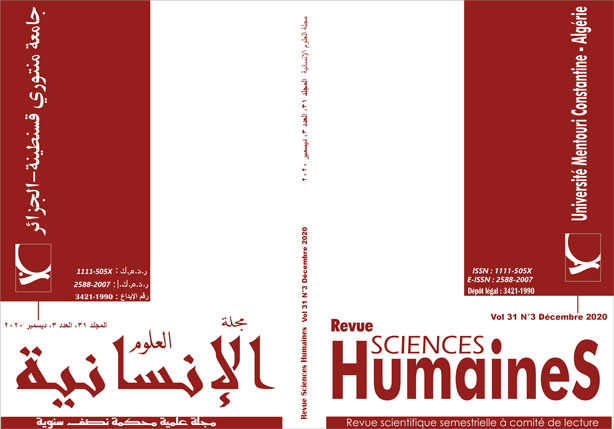Évaluation de l’autonomie de l’apprenant dans le manuel algérien de troisième année secondaire "New Prospects"
Mots-clés :
autonomie, Approche par Compétences, enseignement secondaire, évaluation, New ProspectsRésumé
Cet article évalue le manuel algérien de troisième année du secondaire New Prospects pour découvrir dans quelle mesure son contenu favorise l'autonomie de l'apprenant. New Prospects a été conçu conformément aux principes de l'Approche par Compétences qui visent à produire des apprenants compétents non seulement en classe mais aussi dans leur vie quotidienne en dehors de l'école en favorisant la responsabilité et l'autonomie en eux. L'hypothèse sur laquelle le document est basé est que si New Prospects respecte les principes d'autonomie de l'apprenant tels que stipulés dans l'Approche par Compétence, il parviendra à produire des apprenants autonomes. La méthodologie adoptée dans cet article consiste en une grille d'évaluation élaborée sur la base des principes constituant l'apprentissage autonome identifiés dans la revue de la littérature ici. Les résultats obtenus indiquent que «New Prospects» respecte largement ces principes.
Téléchargements
Références
. Arab, S.A. , B. Riche, M. Bensemmane (2007), New Prospects, Secondary Education Year Three, The National Authority For School publications.
. Barfield, A., Ashwell, T., Carroll, M., Collins, K., Cowie, N., Critchley, M., Head, E.,Nix, M., Obermeier, A. & Robertson, M.C. (2001). Exploring and defining teacher autonomy: A collaborative discussion. In A. S. Mackenzie & E.
. Benson, P.(1997).The philosophy and politics of learner autonomy, In P. Benson and P. Voller (eds), Autonomy and Independence in Language Learning. London: Longman, 1997.
. Benson, P. (2000). Autonomy as a learners’ and teachers’ right. In B. Sinclair, I. McGrath and T. Lamb (eds), Learner Autonomy, Teacher Autonomy: Future Directions. Harlow: Longman.
. Chan, V (2003). Autonomous Language Learning: the teacher’s perspectives. Teaching in Higher Education, 8(1). 33-54.
. Chelli, S (2010) The Competency Based Approach in Algeria: a necessity in the Era of Globalisation.
Retrieved on October 23rd 2019 from: fll.univ-biskra_dz/images pdf…pdf_revue…/chelli%20saliha%20.pdf…
. Dam, L. (1994). How do we recognise an autonomous classroom? Die Neueren Sprachen, 93/5, 503-527.
. Fenner, A.B. & Newby, D. (Eds.). (2000). Approaches to Materials Design in European Textbooks: Implementing Principles of Authenticity, Learner Autonomy and Cultural Awareness. Graz/Strasbourg: European Centre for Modern Languages/Council of Europe Press
. Foroutan, M., N. Nooreen, S. H. Gani, and R. Baki. (2013). The Relationship Between Language Learning Autonomy Extent and Learning Styles in Malaysian Context. World Applied Sciences Journal 24, no. 3 (395-402.
. Graham, S. & Harris, K.R. (2000).The role of self-regulation and transcription skills in writing and writing development. Educational Psychology, 35(2), 3-12.
. Holec, H. (1981). Autonomy in Foreign Language Learning. Oxford. Pergamon.
. Ivanovska, B., (2015), Procedia - Social and Behavioral Sciences. 180 352 – 356. Available online at www.sciencedirect.com
. Lap, T. Q. (2005). Stimulating learner autonomy in English language education. A curriculum innovation study in a Vietnamese context. Doctoral thesis. University of Amsterdam.
. Little, David (1991) Learner Autonomy 1 –Definitions, Issues and Problems. Dublin. Authentic Language Learning Resources Ltd, Trinity College
. Littlejohn, A. (1985) Learner choice in language study. ELT Journal, 39(4). 253-261.
. McCafferty (Eds), Developing Autonomy, Proceedings of the College and University Educators’ 2001 Conference, Shizuoka, Japan, pp. 217-22. Tokyo: The Japan Association for Language Teaching. Available at:http:/www.encounters.jp/mike/professional/publications/tchauto.html
. Naiman N., Frohlich, M., Stern,H.H., & Todesco, A. (1978). The Good Language Learner, Toronto, Ontario Institute for Studies in Education.
. Nunan, D. (1988). Syllabus Design. Oxford: Oxford University Press
. Nunan, D. (1997). Designing and Adapting Materials to Encourage Learner Autonomy. In P. Benson, & P. Voller (Eds.). Autonomy and Independence in Language Learning (pp. 192-203). London: Longman.
. Nunan, D. (2000). Nine Steps to Learner Autonomy. Retrieved September 27, 2019, from http://www.andrasprak.su.se/polopoly_fs/1.84007.1333707257!/menu/standard/file/2003_11_Nunan_eng.pdf
. Oxford, R., L. (1991) Language Learning Strategies, What Every Teacher Should Know. New York: Newbury House.
. Richards, J. C., R. Schmidt. (2003) Longman Dictionary of Applied Linguistics and Language Teaching. Longman Publishing Group
. Riche , B., Arab, S.A., H. Ameziane, H. Hami, K. Louadj (20 ??) At The Crossroads, Secondary Education: Year One/ English. The National Authority For School publications.
. Thanasoulas, D. (2000). What is learner autonomy and how can it be fostered. The Internet TESL Journal 6, no. 11 37-48.
. Waite, S. (1994). Low-resourced self-access with EAP in the developing world: the
great enabler. ELT Journal 48/3, pp. 233–42.
. Weddel, K. S. (2006). Definitions components characteristics integrating competencies and content standards: Mapping competencies resources. Retrieved September, 20th 2019 from
http://www.cde.state.co.us/cdeadult/download/pdf/CompetencyBasedEducation.pdf
. Wenden, Anita, (1987) Learner Strategies in Language Learning. Prentice Hall International English Language Teaching
. Wenden, Anita, (1991) Learner Strategies for Learner Autonomy. Prentice Hall International English Language Teaching.
. Wenden, Anita L. (1998), Metacognitive knowledge and Language learning. Applied Linguistics, v19 n4 p515-37 Dec 1998.
. White, C. (2003). Language learning in distance education. Cambridge: Cambridge University Press
Téléchargements
Publié
Numéro
Rubrique
Licence

Cette œuvre est sous licence Creative Commons Attribution - Pas d'Utilisation Commerciale - Partage dans les Mêmes Conditions 4.0 International.












